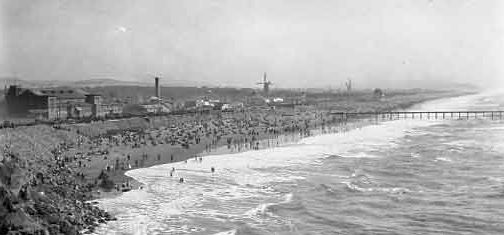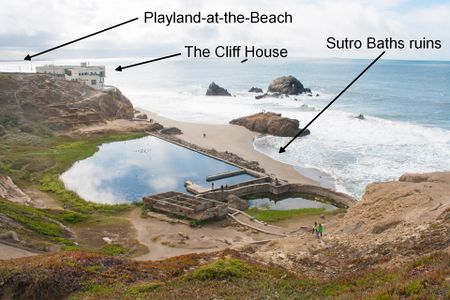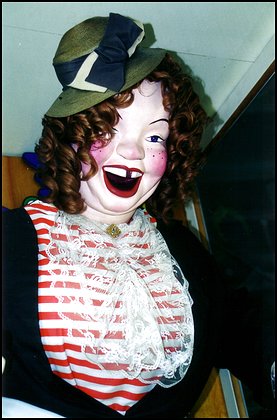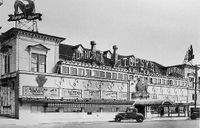Playland
Click here for Bay Area History category page |
Playland (also known as Playland at the Beach and Whitney's Playland beginning in 1928) was a 10-acre seaside amusement park located next to Ocean Beach, at the western edge of San Francisco, California along the Great Highway where Cabrillo and Balboa streets are now. It began as a collection of amusement rides and concessions in the late 1800s, and was known as Chutes At The Beach as early as 1913. It closed Labor Day weekend in 1972.
History
Before Playland
The area that was Playland began as a 19th century squatter's settlement, "Mooneysville-by-the-Sea". By 1884, a steam railroad was in place to bring people to the first amusement ride at the City’s ocean side - a "Gravity Railroad" roller coaster, and to the Ocean Beach Pavilion for concerts and dancing. By 1890 there were trolley lines to Ocean Beach: the Ferries and Cliff House Railroad, the Park & Ocean Railroad and the Sutro Railroad that encouraged commercial amusement development as a trolley park. The Cliff House, which opened in 1863, and Sutro Baths, which opened in 1896, drew thousands of visitors.
The various rides and attractions that began to spring up along the beach were separately owned by various concessionaires. For example, John Friedle owned a shooting gallery and baseball-throwing concession. Some of the rides came from a San Francisco amusement park located on Fulton Street known as “The Chutes" which burned in 1911. The rides that survived that fire were moved, including the "Shoot-the-Chutes" which inspired the first name for the amusement area - Chutes at the Beach. Around 1913, Arthur Looff, leased a piece of land for a carousel and its house - the Looff Hippodrome, located next to John Friedle's concessions. Friedle and Looff become partners in Looff’s Hippodrome and began to buy other concessions to realize their vision of creating "the grandest amusement park on the Pacific coast." A writer for the San Francisco Chronicle in 1922 reported that “by 1921 the owners had spent $150,000 to produce ten spectacular new rides ("clean, safe, moral attractions") which were open from noon to midnight, everyday." Attractions included Arthur Looff’s roller coaster the "Bob Sled Dipper" (also known as "the Bobs") (1921), the Looff-designed Big Dipper roller coaster (1922), Shoot-the-Chutes, the carousel, Aeroplane Swing, the Whip, Dodg-Em, the Ship of Joy, the Ferris wheel, Noah’s Ark, and almost a hundred concessionaires.
In 1923, George and Leo Whitney hit town. The Whitney brothers opened a photographic concession in 1923, pioneering a fast photo-finishing process that allowed people to take pictures home rather than having to wait days for the film to be developed and images printed. By 1924, the Whitney brothers owned four shooting galleries and a souvenir shop in addition to the quick-photo studio .
Playland
In 1926, George Whitney became general manager of the growing complex of seaside attractions. and changed the name to Playland-at-the-Beach. (sometimes known as Whitney's At the Beach). Although the attractions continued to be operated as independent concessionaires, during the late 1920s and '30, especially during the Depression when concessions began to fail, George and Leo began to purchase the attractions outright. The Whitneys bought the Roller Coaster in 1936 and the Merry-Go-Round in 1942. Playland took up three city blocks and in 1934, the Midway had 14 rides, 25 concessions and 4 restaurants besides Topsy’s Roost.
Although Playland's attractions originally sat upon leased land, the Whitneys eventually purchased the land beneath Playland as well as several adjacent lots for future expansion. In 1937, George Whitney, Sr. purchased the then-vacant Cliff House from the Sutro estate and reopened it as an upscale roadhouse that same year. George Whitney was called “The P.T. Barnum of the Golden Gate" as he went on to buy up the concessions and even bought the Sutro Baths in 1952. He bought out his brother in 1952 and continued to operate the area on his own until his death in 1958.
Despite this expansion, the post-war years saw the tearing down of the Shoot the Chutes in 1950, and the Big Dipper in 1955, and after George Whiteney died in 1958, Playland was never quite the same. For a while after George Whitney's death, Playland was operated by his son, George K. Whitney, Jr. and then by Bob Frazier It was eventually sold to Jeremy Ets-Hokin (a millionaire developer) in 1971 and it was torn down in September 4, 1972. Condominiums were built on the Playland property and a permanent art project commemorating Playland was installed in 1996.
Attractions
By 1922 the attractions included Arthur Looff’s “Bob Sled Dipper" (the Bobs) (1921), the Looff-designed "Big Dipper" (1922), the "Shoot-the-chutes", the carousel, Aeroplane Swing, The Whip, Dodg-Em, the Ship of Joy, the Ferris wheel, Noah’s Ark, and almost a hundred concessionaires.
At various times the rides at Playland included: Skyliner, Rocketship, Big Dipper, Big Slide, Dodgem (bumper cars) Limbo (dark house), Kookie Kube, Mad Mine Ride, Scrambler, Twister, Kiddie Bulgy.
Carousel
Arthur Looff actually commissioned the carousel in 1906 for a little amusement park that was originally on Market and Van Ness in San Francisco, but because of the earthquake in 1906 the carousel was shipped to Luna Park, Seattle, Washington. It was not until 1913, that Arthur Looff leased land for the carousel and its house--the Looff Hippodrome -- that the carousel came to Playland. Looff’s Hippodrome at Chutes-at-the-Beach was the first permanently installed concession in 1914. The carousel was an elegant 68-horse merry-go-round with a $5,000 organ, a staggering amount at that time
The carousel was sold at auction in 1972, and went to Long Beach, California. San Francisco bought the carousel and it is now located off Fourth Street downtown in Yerba Buena Gardens.
Fun House
Among the more popular concessions was the Fun House originally called the Crazy House, erected in 1923-24. Laffing Sal was the laughing automated character whose cackle echoed throughout the park. After Playland was closed, one of the original Sal's was relocated to Santa Cruz Beach Boardwalk and another Sal is located in the Musée Mécanique on Pier 45 in San Francisco.
Patrons entered by first passing through the mirror maze, next by squeezing through the spin-dryers and finally by stumbling across the slinky, kinky catwalk. The Fun House had air jets, rickety catwalks, steep and winding staircases, the topsy-turvy barrel and the three-story climb up to the top of "the longest, bumpiest indoor slide in the world" -- and a 200-foot indoor slide.
The famous funhouse mirror sequence at the end of Orson Welles's "The Lady from Shanghai" (1948) was filmed in Hollywood, but the last moments of the movie, the exterior shot of Welles walking past the Funhouse, was filmed at Playland at the Beach.
Fun-Tier
Playland also included a “Fun-tier" Town for “little western gals and little cowboys" which was an area with ten rides geared for children with western motif and a place for birthday parties.
Camera obscura
The Giant Camera obscura was built in 1948-49 as part of the Playland at the Beach amusement area. It was moved to a location next to the Cliff House when Playland closed and is still present in the Cliff House area.
Roller coasters at Playland
- Alpine Racer (1959 - 8/4/1972) The Alpine Racer was originally located on the southeast corner Playland's south block. This area closed in 1964 or 1965 and the Alpine Racer stood idle for about a year until it was moved to the opposite end of the park in the northwest corner of the main block. This was a German-made wild mouse ride imported by Mack Duce's Export Sales Corporation.
- Big Dipper (1922-1955) The Big Dipper opened in 1922 at Chutes at the Beach Park (later known as Playland at the Beach), San Francisco, CA. It was designed by Arthur Looff and lasted 33 years, closing in 1955. (Bobsled Dipper?)
- Kiddie Coaster Steel- ( - 8/4/1972)
- Unknown Steel-1971 or earlier From pictures this roller coaster looks a lot like the "Hi Miler" built by Carl Miller.
Topsy’s Roost
In 1929, George Whitney opened a nearby "chicken shack" restaurant known as Topsy’s Roost located just north of Playland at the foot of Sutro Heights. Driving south along the beach from the Cliff House, the first building you came to was Topsy’s Roost, which become more than just a Chicken Dinner House -- it was also a popular nightclub. It had a live orchestra and dance floor and was decorated so it looked like the patrons were sitting in ramshackle chicken coops. There was seating on the main floor around the dance floor and the balcony. Patrons sitting on the balcony level could slide from their coops down to the dance floor if they wanted to dance. Eventually, Topsy’s Roost closed, and the space became Skateland and, later, the Slotcar Raceway. See also [ Topsy’s Roost ]
Food
The It's It ice cream sandwich was invented in 1928 by George Whitney, and sold only at Playland-at-the-Beach. In fact, for forty years, Playland was the only place you could find It's It. After the demolition of Playland in 1972, the ice cream treat was made and sold elsewhere and is now sold in stores and in fifteen states,
Notes
Playland was used as a plot element in the movie The Lady from Shanghai, starring Rita Hayworth and Orson Welles.
See also
External links
- Playland-Not-At-The-Beach
- PDX.Com History and pictures of Playland At-The-Beach
- Western Neighborhoods Project Memories of Playland
Chat rooms • What links here • Copyright info • Contact information • Category:Root



